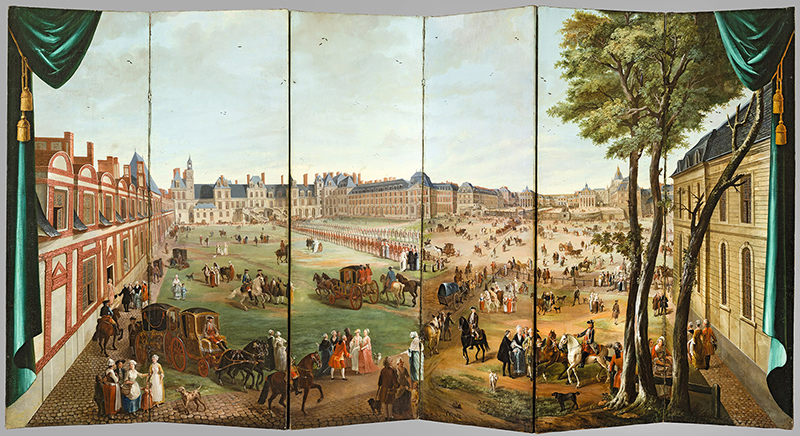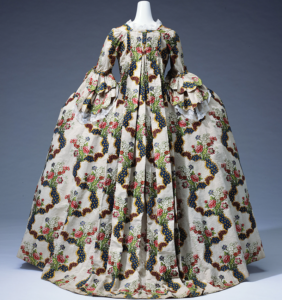
Folding screen with views of the Cour du Cheval Blanc at the Château de Fontainebleau (left) and the Château de Versailles from the Avenue de Paris (right) by Charles Cozette, c. 1768–1770. Collection of Monsieur and Madame Dominique Mégret, photograph by F. Doury, courtesy of the Metropolitan Museum of Art.

Visitors to Versailles: From Louis XIV to the French Revolution, ed. Daniëlle Kisluk-Grosheide and Bertrand Rondot (Metropolitan Museum of Art, distr. Yale Univ. Press, 2018). 370 pp., color and b/w illus.
In 1662 King Louis XIV began making alterations to the hunting lodge he had inherited from his father, Louis XIII. Over the next two decades he built the palace of Versailles and its surroundings, transforming the estate into one of Europe’s greatest royal seats. By 1682, when the Sun King transferred both his royal court and his government there from Paris, visitors were descending on Versailles in droves—officially and unofficially.
Since then, Versailles—residence of the last Bourbon kings before the French Revolution and site of the 1919 peace conference where the treaty ending World War I was hammered out—has continued to be a magnet to callers and sightseers. Its architecture, its decorations inside and out, its parks, plantings, and fountains have inspired artists, architects, historians, and curators. The Metropolitan Museum of Art’s resplendent exhibition, Visitors to Versailles, 1682–1789 (through July 29), takes a novel approach by examining the history and treasures of this regal enclave from the viewpoint of those who were received there. And the richly illustrated catalogue provides a sumptuous key to the show.

Pair of cups and saucers (tasses litrons) with portraits of Marie Antoinette and Louis XVI, Sèvres Manufactory, 1782. Nationalmuseum, Stockholm, bequest of Consul Hjalmar Wicander and Eva Charlotta Mörner.
Edited by two leading scholars at the Met and Versailles, respectively, its essays by eminent specialists cover a surprising variety of topics, including the various modes of transportation needed to travel to the palace from Paris and the variety of guidebooks and engraved imagery published for visitors of every rank and exotic origin. We find discussions of ambassadorial visits and the exchange of precious gifts (from jewel-encrusted snuffboxes to sculpture, paintings, and tapestries). There’s even an examination of the ways in which royalty visited incognito—some to avoid complex protocol, others to cut costs. Pascale Gorguet Ballesteros’s essay “Exchanging Looks: Codes of Dress at Versailles,” and Paul Staiti’s account of Americans at Versailles form a provocative dialectic illustrating, on one hand, the rigid formalities of court attire, and, on the other, how Benjamin Franklin, John Adams, Thomas Jefferson, and other representatives of the newly formed United States tried to maintain republican sartorial simplicity within the elaborate Versailles conventions.

Silk brocade dress (grande robe à la française), French, c. 1775–1785. Kyoto Costume Institute, Japan, © The Kyoto Costume Institute; photograph by Takashi Hatakeyama.

Louis XV by Augustin Oudart Justina, c. 1717. Musée National des Châteaux de Versailles et de Trianon; photograph by Christophe Fouin, © RMN-Grand Palais/Art Resource, NY.
Editors and contributors have done a splendid job of examining their subjects with clarity and elegance. Each essay or subject group is followed by a generously illustrated catalogue section related to the topic, making the volume as inviting to consult as it is entertaining to read. Most particularly, we can sense the sheer scholarly exhilaration of the contributors, who mined more than a century of memoirs, diaries, and letters that vividly document visitors’ thoughts and impressions. In the Sun King’s time, Antonio Farnese, the future Duke of Parma, was dazzled by “gold, paintings, bronzes, marbles . . . [that] sparkle and embellish even the everyday and ordinary.” A century later, Jefferson, concluding his tenure as US minister to Louis XVI’s France, fretted, “I cannot rec[ei]ve the accustomary present from the king” because of a “clause in our new constitution.” It was the emoluments clause that concerned Jefferson. What would he think nowadays?

